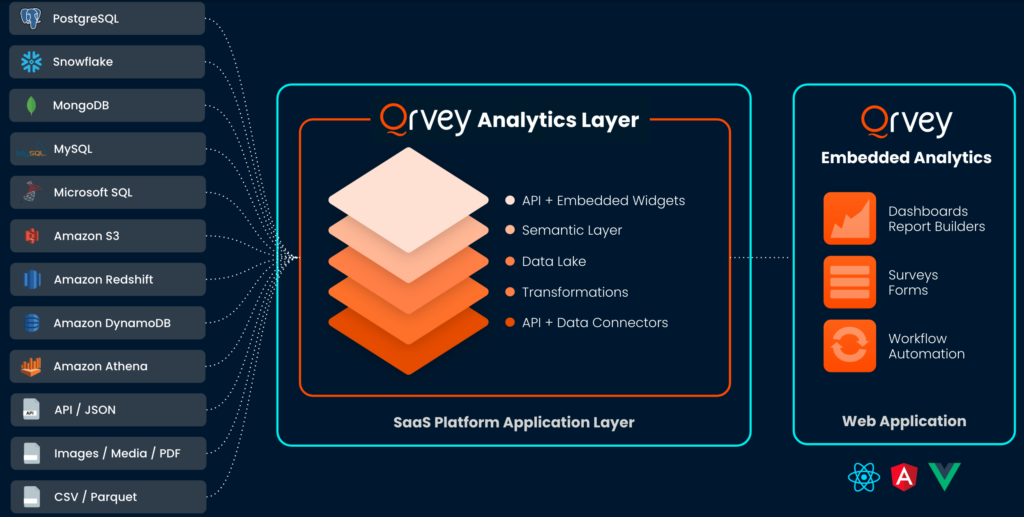Intro to Qrvey
The Qrvey platform is an all-in-one analytics solution that enables SaaS providers to put analytics in the hands of their users.
It's like "cheat codes" for SaaS companies that need dashboard analytics, reporting, and automation built into their app – fast!
How it Works
With Qrvey, take your analytics from "zero-data to embedded" in a few short steps:
- Launch the Qrvey Platform – Powered by Docker + Kubernetes. Run it on your favorite supported cloud provider!
- Connect Your Data – Any database, any source. SQL, NoSQL, data lakes, CSV, JSON, APIs... You name it!
- Create Datasets – Transform, combine, synchronize, and set permissions on data so it's fit for analytics.
- Build Dashboards – Interactive. Customizable. Drag n Drop!
Craft a first-class analytics experience, custom-tailored for the needs of your SaaS org and end-users. - Embed & Go – Copy/paste & configure dashboards straight into your app in minutes.
And that’s just the start! Qrvey also provides...
- Pixel-Perfect Reports – Generate polished, data-driven reports.
- Automated Workflows – No-code, automated workflows for pretty much whatever you need.
- Content Deployment – Automagically move Qrvey data & content around however you need.
- Granular Roles & Permissions – Control exactly who sees what. Both on your Saas team and for your end users.
No matter your data model or tech stack, Qrvey gives you an end-to-end embedded analytics platform — with all the bells, whistles, and flexibility your users expect.
Anatomy of the Qrvey Platform

Qrvey is made up of four core components, each designed for a specific role in your embedded analytics workflow:
- Qrvey Composer — A no-code/low-code app for your Saas team to build & manage Qrvey.
- Qrvey Admin Center — The command center Admins to configure, manage, and monitor the Qrvey environment.
- Data Engine — Our powerful data engine. Handles data ingestion to power end-user analytics.
- Embedded Analytics Widgets — Like “Lego bricks” for analytics! Embed & configure dashboards right into your SaaS app!
Who's Qrvey For?
Literally any SaaS company that needs analytics for their end users.
SaaS Companies
Qrvey is designed to meet the needs of any SaaS company, regardless of data type, source, or model. It empowers you to deliver dashboards and analytics within your app—without the time, cost, and complexity of building data infrastructure, pipelines, user permissions, middleware, synchronization, and frontend analytics UIs from scratch.
Your SaaS Team
There's typically four types of folks on your team that use Qrvey:
- CloudOps Engineers – The cloud gurus that deploy, upgrade, and keep your Qrvey platform humming.
- Solution Architects – The data masterminds who architect the perfect data pipeline for your business needs.
- Data Analysts – The data detectives who build datasets and dashboards, making insights pop for your end-users.
- Software Developers – The front-end wizards that weave Qrvey’s analytics magic right into your app.
They typically take on one of two roles:
- Administrators – To manage and monitor the platform infrastructure: user access, Data Router, Elasticsearch indexing, and deployment between environments. They don’t touch the actual dashboard content — that’s the Creator’s job.
- Creators – To set up datasets and build visualizations and dashboards. Creators might be Data Analysts using Qrvey Composer or Developers embedding widgets and APIs.
- [Custom Roles] – You can also create more custom roles and customize permissions, based on your team's needs.
Your End Users
These are the external users — your customers — who interact with Qrvey inside your app. You may group them as individuals, or organizations composed of individuals, or some other way!
- Viewers – This will be the majority of your end users. They view embedded dashboards, charts, and widgets — no editing needed.
- Power Users – Advanced users who go hands-on to create their own dashboards, visualizations, and custom assets using the datasets you provide.
Get complete row-level and column level security over every single widget embedded instance.